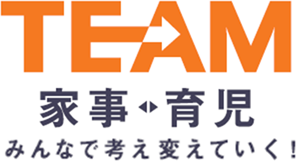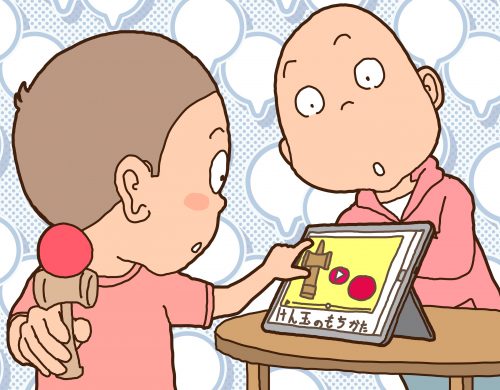Table of Contents
- Parenting cartoon, “How to keep your distance from your phone.”
- How should we interact with them? The Latest in Children’s Media Literacy
- Are the Children of 2021 Safe? Let’s have fun with the media!
Parenting cartoon, “How to keep your distance from your phone.”
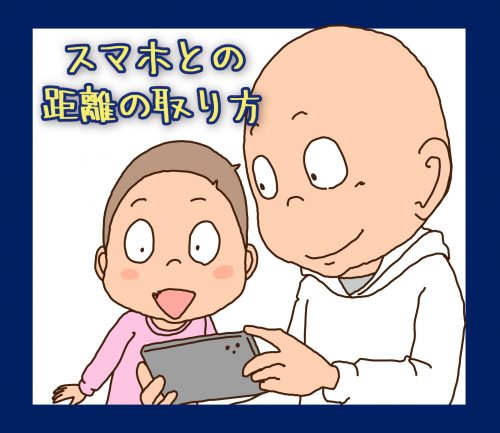

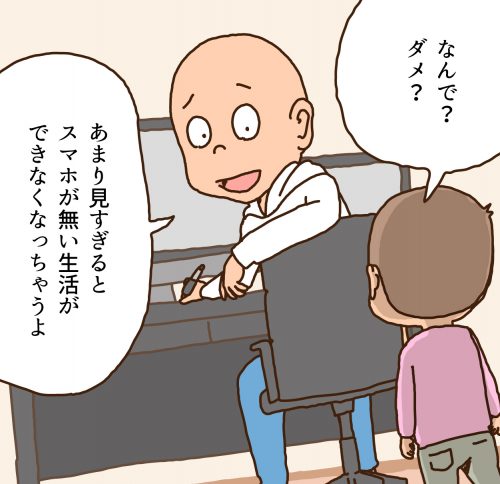
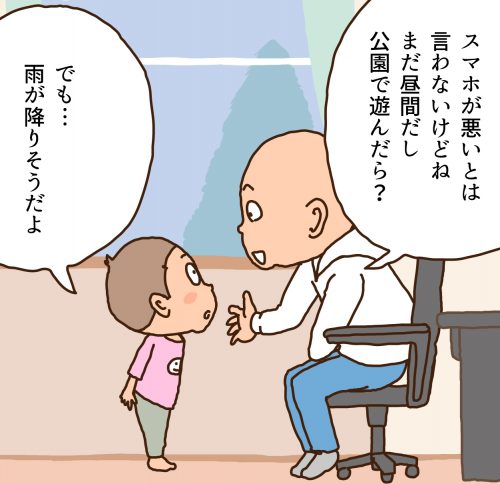
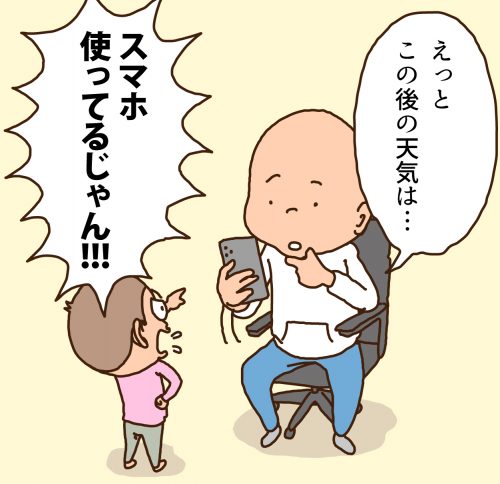

Profile
Eiichi
After working for a design company in Tokyo, he became a freelance illustrator. He is a hard-working father who creates animation, manga, and illustrations, including winning the Yubari International Fantastic Film Festival’s International Short Film Showcase Division Excellence in Animation Award.
How should we interact with them? The Latest in Children’s Media Literacy
Children today are surrounded by smartphones, the Internet, etc. from the time they are born.
How should I go out with them? Many fathers and mothers must be wondering, “How should I deal with them?
This time,
A real-life example of one family and advice from an expert!
How does everyone else do it, in the case of the A’s?
The A family has a 7-year-old girl and a 3-year-old boy.
Mr. A’s children are learning many things by enjoying video content on their smartphones, tablets, DVDs, etc.
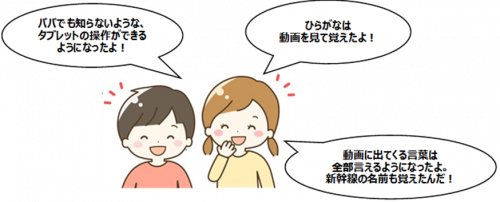
On the other hand, dads and moms have some trouble.
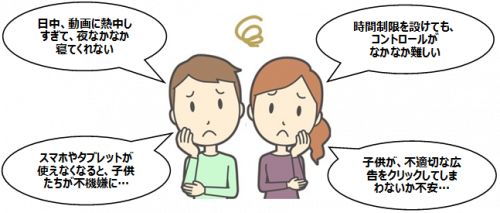
The environment for children today has changed drastically from when the fathers’ generation was children. How should we respond to this change?
Are the Children of 2021 Safe? Let’s have fun with the media!
From here, we asked Professor Mami Komatani of the Faculty of Humanities and Social Sciences at Jissen Women’s University, who specializes in media information literacy and media psychology, for advice on how to deal with the media in early childhood (ages 1-5), when involvement with the media in daily life and play is increasing.

Development of children of the socially native generation: advantages and disadvantages of media.
Children are “social natives,” growing up surrounded by social media from birth. We will discuss the advantages and disadvantages of children’s development in relation to media.
[Benefits]
Children are interested in media such as smartphones and tablets and use them as tools for adventure . There is no fear, resistance, or aversion (technophobia) toward new media, and they operate and use devices intuitively and sensitively.
○Your child will grow up in the ICT environment of “informatization of education,” which has been in full swing since 2020. By the time your children reach childhood, an environment where they learn with electronic blackboards, digital textbooks, and tablet terminals awaits them at elementary school. Increasingly, kindergartens, nursery schools, and childcare centers are also incorporating ICT into their childcare programs, and children will play and learn surrounded by media in educational settings other than the home. Opportunities for play-to-learning will expand through the media.
[Demerit.]
○ Information from the media is always-on, so we tend to contact the media unprotected. This leads to the danger of believing information from the media.
○The trendy virtual reality (VR), augmented reality (AR), and mixed reality (MR) virtual spaces, which “make things that do not actually exist seem real,” have the advantage of allowing people to experience the extraordinary in a realistic way. However, children are lost between media fantasy and reality in these virtual spaces. Originally, children in early childhood have a magic window perspective (misunderstanding what appears to be real as reality in the world represented by the media). Usually, around the age of 4, when they begin to understand others, they begin to think, “Someone else is making the cartoons and videos. The world created by the media is different from the reality we live in” gradually begins to be understood. However, there is a concern that the dramatic evolution of VR, AR, and MR is confusing and delaying children’s understanding of media.
Tips on how to have fun and work well with the media
[Image of a tricycle].
○The way children interact with the media in their early childhood is like a “tricycle” compared to a bicycle. The presence of both “mechanical restrictions” and “parents” is essential as children take the first step to pedaling on their own. In both cases, the first step is when the child begins to use the media.
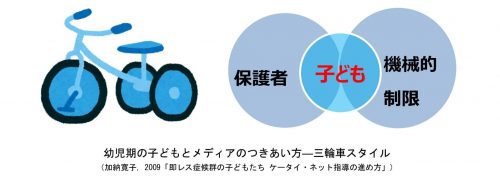
[Firmly physically guarded by restricting functionality].
○ Set passwords or ecological authentication to prevent children from opening the door without permission.
○Set up watchful waiting settings for games and filtering or family sharing settings for smartphones to prevent access to inappropriate game software, websites, and content.
○ Set the time of use, including timers and overtime alarms.
♦Since children under 6 years old in particular are still developing their vision, the screen setting should be changed from 3D to 2D images. (What we would like to tell you about 3D images on the Nintendo 3DS: https://www.nintendo.co.jp/support/3ds/info.html)
Psychological follow-up with parental control [parental monitoring and restrictions].
○Parents should always check in advance whether the game software and smartphone apps to be used are appropriate for their children and use those that they deem appropriate.
○Be sure to operate the game or smartphone with your child when he or she uses it for the first time.
○*Notice where your child shows interest in game software and smartphone apps.
○ Regularly check game play time, software played, and smartphone browsing history, and always maintain a stance of being there for your child.
(Human Academy Institute for Children’s Education, 2021, “Teach us! Komatani-sensei, Vol. 2: What is “media information literacy” you want to know in child-rearing? (excerpted from https://kids.athuman.com/cecoe/articles/000173/)
[I’m convinced that if parents and children make it together! You can protect it! Media Rules]
○It is important for parents and children to “enjoy deciding together” and to “take it easy little by little within the limits of what you can do. For example, you and your child can choose a “fun timer sound” together and set it. This way, your child will take the initiative to set the timer because he or she chose it.
○○ There is also a “smart phone futon” (withnews, 2016, “‘Smart Phone Futon’ Principal Inspired! Unexpected Usage Maker Surprised”). Since young children have animistic thinking (anthropomorphizing lifeless things), it is important to say to them, “When your phone gets hot, your phone is tired too. It’s a good idea to say to them, “Let’s give it a rest.
○Pressures such as “You must follow it” or “00-chan is doing it neatly” are not legal. By making media rules a part of your daily life, it will become a habit.

The “smart phone futon” in the photo was purchased by Komatani from Gacha Gacha. (Human Academy Institute for Children’s Education, “Teach us! Dr. Komatani, No. 2: What is “media information literacy” you need to know in raising children?” ( Aug. 20, 2021, https://kids.athuman.com/cecoe/articles/000173/)
It’s normal to worry! Parenting Styles for a New Era
In terms of media generations, parents are “digital natives” and their children are “social natives” who have grown up surrounded by social networking media since birth. Please dispel the stereotype that “we understand each other because we grew up with the same digital media. Your children will be social media communicaiton as if they were breathing.
In the current “there is social media” situation, parents are raising their children in a historically new way. Naturally, in addition to normal child-rearing, your children’s involvement with the media will cause more confusion and distress. The pitfalls of media may become more serious as your children grow older, from childhood to elementary school and adolescence to middle and high school.
I hope that the parents who are the readers of Dad’s Style will have the attitude of “know the advantages and disadvantages of social media and fear it correctly” and take pride in “being the gatekeeper and the first teacher in order to have fun with the media”. I hope that parents will take pride in the fact that they are the Gatekeepers and First Teachers in order to have fun and enjoyable relationships with the media.
In this issue, we have discussed a few tips on how to deal with the media. This is a good place to start. At Papa’s Style, we encourage you to “work on housework and childcare as a TEAM,” but we would be happy if you could also incorporate the idea of having a good and enjoyable relationship with the media.

